From the book Assault from the Sea by Curtis A. Utz
On the morning of 13 September, Rear Admiral John M. Higgins's gunfire
support ships steamed up the narrow channel toward Inchon. At 1010, during
the day's first flood tide, destroyers Mansfield (DD 728) , De
Haven (DD 727), Lyman K Swenson (DD 729), Collett (DD
730), Gurke (DD 783) and Henderson (DD 785), followed by
cruisers Rochester, Toledo, HMS Jamaica and HMS Kenya, entered
the outer harbor. Aware that one disabled ship could block the vital
channel, destroyer officers had their boatswain's mates rig towing gear to
quickly pull a damaged or grounded ship out of the way. Repair parties,
armed with Browning automatic rifles, carbines and submachine guns, stood
by to repel enemy boarders who might attack from nearby sampans or the mud
flats. Overhead, a combat air patrol of Task Force 77 Grumman F9F Panther
jets provided cover.
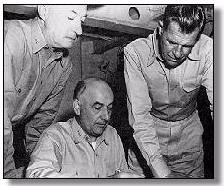 Rear Admiral
James H. Doyle, Commander Task Force 90; Vice admiral Arthur D. Struble,
Commander Joint task Force 7; and Rear Admiral John M. Higgins, Commander
Task Group 90.6, confer on board Struble's flagship, heavy cruiser,
Rochester (CA 124), on 13 September, 1950
Rear Admiral
James H. Doyle, Commander Task Force 90; Vice admiral Arthur D. Struble,
Commander Joint task Force 7; and Rear Admiral John M. Higgins, Commander
Task Group 90.6, confer on board Struble's flagship, heavy cruiser,
Rochester (CA 124), on 13 September, 1950
At 1145, a lookout on Mansfield cried out, "Mines!"
Commander Oscar B. Lundgren, De Haven's commanding officer and a
mine warfare expert, spied the menacing black shapes of 17 contact mines.
The three leading destroyers fired on the mines with their 20mm and 40mm
guns, plus small arms. A thunderous explosion tore through the air and a
plume of muddy water leapt skyward as one mine exploded. Captain Halle C.
Allen, Commander Destroyer Squadron 9, ordered Henderson to stay behind
and eliminate the remaining mines. Soon afterward, the destroyer sailors
discovered, from the piles of Soviet-made mines they spied ashore, that
the enemy was in the process of completely mining the water approaches to
Inchon.
As the ships moved to their firing positions, propeller-driven Douglas
AD Skyraiders from Philippine Sea blasted Wolmi Do with bombs,
rockets and gunfire. The cruisers remained in the outer harbor, while the
destroyers dropped anchor above and below the island. The destroyers swung
on their anchors on the incoming tide, bows downstream, prepared to exit
quickly, if necessary. The gunners loaded their five-inch guns, trained
them to port and located their assigned targets.
"Ten enemy vessels approaching Inchon," the North Korean
commander radioed in the clear to NKPA headquarters in Pyongyang. He
added, "Many aircraft are bombing Wolmi Do. There is every indication
that the enemy will perform a landing." The Communist officer assured
his superiors that his defense force was prepared for action and would
throw the enemy back into the sea.
In De Haven's gun director, Lieutenant Arthur T. White saw North
Korean soldiers run out and load a gun just north of Red Beach. White
requested permission to open fire and Lundgren gave it. De Haven's fire,
which quickly eliminated the enemy weapon, proved to be the opening salvo
of the prelanding bombardment.
The object of this effort was to stimulate the enemy guns in Inchon and
emplaced on Wolmi Do to return fire so the UN ships could target and
destroy them. For a long eight minutes, the North Koreans failed to rise
to the bait. But then the defenders, men of the 918th Coastal Artillery
Regiment, wheeled out their weapons-mainly Soviet-made 76mm anti-tank
guns-and opened fire, hitting Collett seven times, Gurke three.
The response was devastating. The gunfire support ships poured 998
five-inch rounds into the island and defenses in front of the city. At
1347, with many enemy guns silenced, Allen signaled the retirement order
to his destroyers, which headed for the open sea. The cruisers provided
covering fire for this movement and then brought up the rear of the
column.
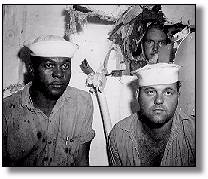 North
Korean guns emplaced ashore returned the fire of the Allied surface ships,
sometimes with telling effect. Sailors pose with a hole blown in the
destroyer Collett (DD 730) by a Communist 76mm gun
North
Korean guns emplaced ashore returned the fire of the Allied surface ships,
sometimes with telling effect. Sailors pose with a hole blown in the
destroyer Collett (DD 730) by a Communist 76mm gun
Before the ships could clear the harbor, however, one of the few
remaining Communist guns exacted revenge on Lyman K Swenson. Two
North Korean shells exploded just off the destroyer's port side, killing
Lieutenant (jg) David H. Swenson, ironically the nephew of the sailor for
whom the ship was named. Enemy fire wounded another eight men in the
bombardment force that day.
That night Higgins and Allen conferred with Struble in Rochester. Although
pleased with the day's action, Struble ordered the ships and aircraft to
give Wolmi Do "a real working-over" the following day. The mine
threat remained because gunfire had eliminated only three of the devices
and the task force minesweepers were several hundred miles away from
Inchon. Because of the lack of small combatants, the minesweepers had been
assigned to troop transport escort duty. Struble now ordered the ships to
make best speed to the operational area, even though they would not arrive
until 15 September. Soon after midnight the admiral dismissed his officers
so they could grab a few hours of sleep and prepare for the next day's
combat.
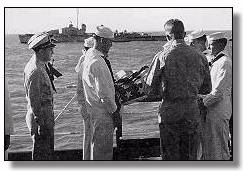 Sailors
prepare to commit the body of Lietenant (jg) David Swenson to the deep on
the morning of September 14.
Sailors
prepare to commit the body of Lietenant (jg) David Swenson to the deep on
the morning of September 14.
The following morning, the ships of the bombardment group hove to, with
colors at half-mast and crews at quarters. A boatswain's mate in Toledo piped "All hands to bury the dead." After a simple service,
a Marine rifle salute and the playing of "Taps", bluejackets
committed Lieutenant (jg) Swenson's remains to the deep. Somber but
determined after this ceremony, the men of the cruiser-destroyer group
again prepared for action. Note
The ships once again moved up Flying Fish Channel. As the force closed
Inchon, Toledo fired on one mine, exploding it. The damaged Collett dropped off and destroyed another five of the deadly "weapons
that wait."
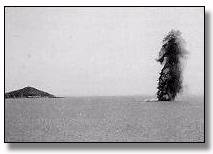 Naval
gunfire from heavy cruiser Toledo (CA 133) explodes a Soviet-made sea mine
in the approaches to Inchon on September 14. If the enemy had had more
time to lay mines off Inchon, the result might have been disastrous to the
operation
Naval
gunfire from heavy cruiser Toledo (CA 133) explodes a Soviet-made sea mine
in the approaches to Inchon on September 14. If the enemy had had more
time to lay mines off Inchon, the result might have been disastrous to the
operation
At 1116, when they came in range of targets ashore, the cruisers loosed
a salvo. NKPA gunners then opened up on HMS Kenya, the closest
cruiser to shore. Captain Patrick W. Brock, RN, Kenya's skipper,
felt that "the enemy gunners were either very brave or very
stupid," because even before the cruiser could return fire, attack
aircraft obliterated the offending guns. In the next 75 minutes, the
destroyers hurled over 1,700 five-inch shells into Wolmi Do. The cruisers
reentered the fray and as Marine and British Fleet Air Arm pilots spotted
targets, they blasted positions near Inchon and on Wolmi Do. One Valley
Forge pilot observed that "the whole island," referring to
the once-wooded Wolmi Do, "looked like it had been shaved."
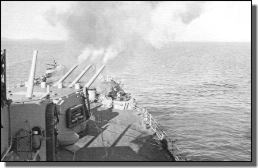 The
after turret on Toledo (CA 133) fires a salvo of eight-inch rounds at
targets near Inchon during the preinvasion bombardment.
The
after turret on Toledo (CA 133) fires a salvo of eight-inch rounds at
targets near Inchon during the preinvasion bombardment.
The Advance Attack Group, then in the Yellow Sea, stood in toward
Flying Fish Channel. Near dusk and sixty-five miles from the objective,
Commander Clarence T. Doss, Jr., in charge of three rocket bombardment
ships (LSMRs), spied a huge pillar of smoke on the horizon to the east.
Doss knew this meant that UN ships and planes were plastering the enemy
defenders. He passed that "welcome news" to all hands.
[ Up ] [ Six Brave Ships ] [ Eddie Snelling's Inchon Invasion Photos ] [ Gunnery Officer's View ] [ Bob Sauer Remembers ] [ 10 Enemy Vessels Approaching ] [ Enemy Vessels Approaching ] [ Land The Landing Force ] [ Assault on Red Beach ] [ Operation Chromite ] [ Shoot Us If You Can ] [ The Taking of Wolmi-do ]